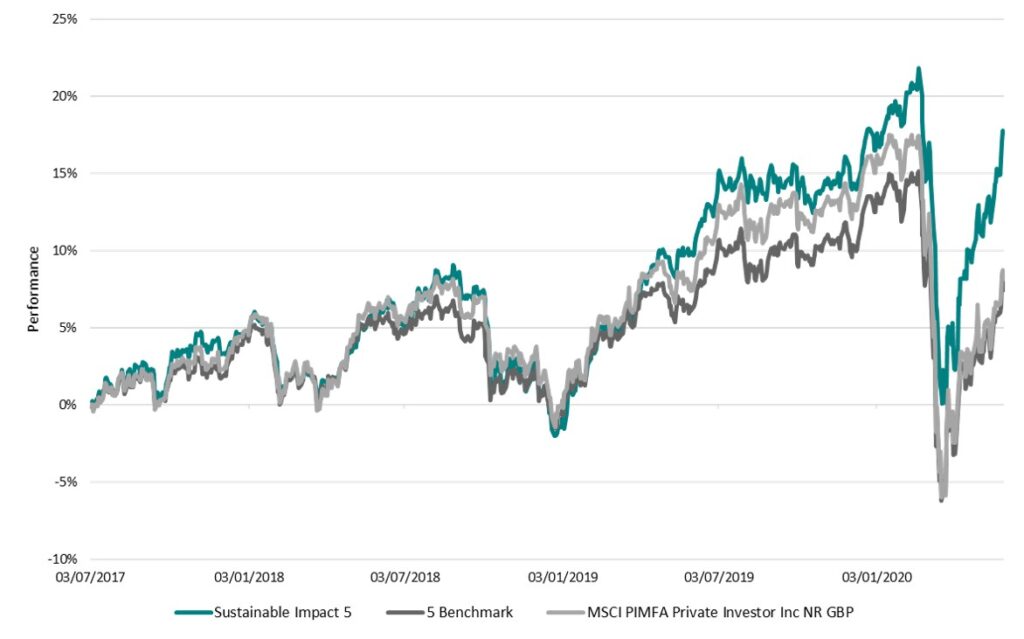As part of the three-year birthday celebrations for our Sustainable Impact Portfolio, we’ve created a three-part guide to Environmental, Social & Governance (ESG) investing. The series looks at the key areas around ESG investing, including how new regulations are driving interest in the ESG arena, how advisers can meet clients’ ESG objectives, and much more. Jon Smith, Manager of the Casterbridge Sustainable Impact portfolios, begins by taking a closer look at the risks associated with ESG investing and asks the question….
Does an ESG portfolio have to be riskier than a traditional portfolio?
Ethical investing has always carried the stigma that ‘you must give something up’ to ensure you invest according to your moral compass. This sacrifice is usually in the form of financial return, due to the exclusions placed on certain sectors or areas of the investment market such as tobacco, mining, and oil.
Sustainable investing is different. Instead of focusing on restrictions, ESG factors are positive contributors, used to create value and potential growth for a portfolio. The aim is to identify companies that contribute positively to society and the environment, whilst making a meaningful and lasting impact on the world. By placing ESG factors at the forefront of investment decisions, issues such as climate change, pollution, stakeholder rights and corporate board transparency should position these companies as leaders within their respective industries.
Asset allocation in sustainable portfolios
In any portfolio, suitability is the most important consideration. An investor rated 5 out of 10 in terms of their attitude towards risk should be invested in a portfolio also risk-rated 5 out of 10. Most ‘ethical’ portfolios carry outsized risks in asset allocation due to the lack of available investments. At Casterbridge Wealth, our Sustainable Impact Portfolio approaches risk in the same way as our traditional portfolios. We use the same strategic (long-term) asset allocation and compare portfolio performance to the same benchmark, ensuring that investor suitability always remains aligned with their objectives.
Asset allocation vs benchmark – June 2020

Sector allocation in sustainable portfolios
Sustainable investing can be similar to a thematic portfolio (which groups together investments from the same sector or the same theme). Naturally, a sustainable portfolio will have lower weightings to sectors such as materials, consumer brands and energy, and higher exposures to sectors such as healthcare, industrials, and technology. Healthcare is a large part of social wellbeing, both in providing services to an aging demographic and through the discovery of new disease-preventing drugs. Industrials and technology are large weightings because sustainability is typically at the forefront of innovation. Companies that are developing new technologies that are more efficient are, by their nature, more sustainable. Typically, the fund managers within our Sustainable Impact Portfolios aim to invest in the components of new and exciting technologies (i.e. battery production or renewable energy) to avoid the high-risk nature of research and development.
There is an increased sector-specific risk within sustainable investing with larger exposures to healthcare and technology. For example, US politics, high valuations and changes to regulation could cause higher short-term volatility to that of the wider market, but we believe that – in the long-run – these sector overweights are where the most exciting growth opportunities are, and where any investor would want to be positioned.
Equity sector breakdown – June 2020

So, what does this all mean for risk and returns?
By minimising exposure to the likes of energy and materials, the portfolio should be less exposed to cyclical markets and recessions. In fact, in February 2020, our Sustainable Impact portfolios held up particularly well through the outbreak of Covid-19 and subsequent market crash, as can be seen below.

In this crash, companies that were highly linked to consumer spending, manufacturing, or overall GDP were hit hardest and share prices fell accordingly. Our Sustainable Impact portfolio captured ~50% of the drawdown and ~70% of the upside upon market recovery. In other words, during one of the sharpest falls in stock market history, our Sustainable Impact portfolios fell less sharply than more traditional investments, and recovered far quicker. This has led to strong overall outperformance to date.
Sustainable Impact Portfolio performance


In Summary
A sustainable portfolio does not need to carry more risk than a traditional investment portfolio. While focusing on innovation and building a more positive future, could lead to higher short-term volatility which clients should always be aware of, this is not always the case – as demonstrated by the recent Covid-19 market volatility. We believe that, in the long-run, these sectors and companies are driving change for the better, and will provide healthy returns whilst doing so.
You can get much more information on our Sustainable Impact Portfolio range here
Guide to ESG investing – Part 2: Are you aware of the new ESG regulations? Coming Soon…
Important Information
This guide is for information only and does not constitute advice or a recommendation and you should not make any investment decisions on the basis of it. The views and opinions within this document are those of Casterbridge Wealth at time of writing and may change without notice. They should not be viewed as indicating any guarantee of return from an investment managed by Casterbridge Wealth nor as advice of any nature. Past performance is not a guide to the future. The value of an investment and any income from it may go down as well as up and the investor may not get back the original amount invested.





